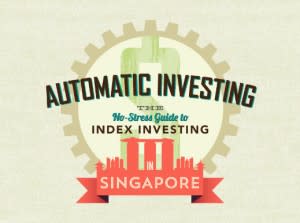Just Started Investing? This Is The Biggest Mistake Beginners Make
When it comes to investing, it’s hard enough to even understand the universe of things you can invest in, let alone figure out the deep quagmire of financial statistics and analysis that is available. Our guest columnist, Lionel Yeo, shares with us the biggest mistake anyone new to investing could make:

Let’s say that you wanted to learn tennis. What’s the first thing you should focus on? Should you figure out which racquet to buy? Whether it has a leather grip or fiberglass frame? Should you buy shoes that suit the surface you’re playing on?
No, you weirdo. The first thing you should do is grab any tennis racquet, put on some old sneakers, and hit a couple of thousand shots. Practice. Work on your technique. Everything else is a distraction.
Yes – details like your choice of racquet or shoes might tweak the performance of someone like Andre Agassi. But even if I had the best tennis racquet in the world, Andre Agassi would still beat the crap out of me with a lousy wooden racquet.
When you’re a beginner, details like these don’t matter. They only serve to distract you from the big picture.
The biggest mistake that beginners make is to focus way too much on the minutia.
Stuff That Sounds Important, But Doesn’t Actually Matter
The same goes for investing. Consider the stuff that preoccupies investors these days:
Financial news: CNBC gives us a neverending deluge of information, complete with flashy charts to make us believe this stuff is important. OMG the Fed is tapering their bond purchases! Investors are getting nervous about Crimea! The P/E ratio of the stock market is too high!
How the market is doing: Amateur investors love to debate over when’s a “good” time to invest. Remember
At its core, investing boils down to just two things:
Invest in assets
Diversify across them
Depending on who you talk to, “assets” might sound like a boring accounting term, or a vaguely dirty idea. (Sorry, I couldn’t resist) But at its core, assets are simply stuff that will produce more value in the future.
Farmland is an asset. Real estate is an asset. A bond is an asset (because it pays you interest). A stock is an asset (because it lets you partially own a business). A stock market is an asset. Focus on owning assets, and you’re on the right track.
Do you need to own every single asset? Nope. As Warren Buffett says: “No one has the ability to evaluate every investment opportunity.” Pick the simplest ones (we’ll talk about them in a second), and move on.
Next comes the issue of risk. Nobody is perfect when it comes to investing. No matter how valuable you think an asset is, anything can happen. Russia can default. Lehman Brothers can fail. Singtel can start charging for Whatsapp (horrors!).
Which is why we spread out our risk by diversifying. We buy many different assets. We buy many different types of assets. That way, no single event can cripple us. As long as you’re diversified, things will turn out fine over the long run.
Invest in assets. Diversify across them. That’s all you need to know.
How Normal People Should Invest (Plus An Update On The Upcoming Ebook!)
“But wait,” I hear you say, “How do I figure out which assets to buy? I don’t know anything about Finance!”
Relax. Remember what we said at the beginning. You don’t need to know complicated financial formulae. You don’t even need to learn how to pick stocks. Investing is actually much simpler than that.
As Warren Buffett wrote in his latest letter to Berkshire Hathaway shareholders:
I have good news for these non-professionals: The typical investor doesn’t need this skill (of evaluating business prospects)… The goal of the non-professional should not be to pick winners – neither he nor his “helpers” can do that – but should rather be to own a cross-section of businesses that in aggregate are bound to do well. A low-cost S&P 500 index fund will achieve this goal.
A low-cost S&P 500 index fund containing 500 different stocks. It not only owns assets, but it also diversifies across them. It’s so simple, it’s brilliant.
By the way, you don’t have to settle for just the S&P 500. You can localize it by investing in a Straits Times Index fund. You can go global by investing in an international stock market index. You can even diversify by investing in a bond market index to protect you during the bad times.
Yes, that sounds like a lot of options, but it’s really quite simple. And I’ll show you how to start investing in indexes in my upcoming ebook Automatic Investing – which will be launched by end-March.
Automatic Investing thumbnail H If you’re a beginner investor, I think this is really gonna help you. You’ll learn a simple, step-by-step process to create and execute your own investing strategy. You’ll get exact examples of the assets I invest in and the services I use. And above all, I’ll guide you through with specific, achievable Action Steps.
Even if you choose not to buy it, that’s totally cool. Just remember to always go back to the basics: Invest in assets. Diversify across them.
Focus on the big picture, and you’ll be on the right track.
Lionel writes at cheerfulegg.com, which aims to help people hatch a rich life. As a special download for MoneySmart readers, click here to download his free ebook Small Tweaks – that’ll show you how to boost your savings by $300 every month.
Image Credits:
t0mskGet more Personal Finance tips and tricks on www.MoneySmart.sg
Click to Compare Singapore Home Loans, Car Insurance and Credit Cards on our other sites.
More From MoneySmart


